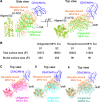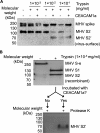Structure of mouse coronavirus spike protein complexed with receptor reveals mechanism for viral entry
- PMID: 32150576
- PMCID: PMC7082060
- DOI: 10.1371/journal.ppat.1008392
Structure of mouse coronavirus spike protein complexed with receptor reveals mechanism for viral entry
Abstract
Coronaviruses recognize a variety of receptors using different domains of their envelope-anchored spike protein. How these diverse receptor recognition patterns affect viral entry is unknown. Mouse hepatitis coronavirus (MHV) is the only known coronavirus that uses the N-terminal domain (NTD) of its spike to recognize a protein receptor, CEACAM1a. Here we determined the cryo-EM structure of MHV spike complexed with mouse CEACAM1a. The trimeric spike contains three receptor-binding S1 heads sitting on top of a trimeric membrane-fusion S2 stalk. Three receptor molecules bind to the sides of the spike trimer, where three NTDs are located. Receptor binding induces structural changes in the spike, weakening the interactions between S1 and S2. Using protease sensitivity and negative-stain EM analyses, we further showed that after protease treatment of the spike, receptor binding facilitated the dissociation of S1 from S2, allowing S2 to transition from pre-fusion to post-fusion conformation. Together these results reveal a new role of receptor binding in MHV entry: in addition to its well-characterized role in viral attachment to host cells, receptor binding also induces the conformational change of the spike and hence the fusion of viral and host membranes. Our study provides new mechanistic insight into coronavirus entry and highlights the diverse entry mechanisms used by different viruses.
Conflict of interest statement
The authors have declared that no competing interests exist.
Figures






Similar articles
-
Biochemical analysis of packing and assembling heptad repeat motifs in the coronavirus spike protein trimer.mBio. 2024 Nov 13;15(11):e0120324. doi: 10.1128/mbio.01203-24. Epub 2024 Oct 23. mBio. 2024. PMID: 39440974 Free PMC article.
-
Glycine 29 Is Critical for Conformational Changes of the Spike Glycoprotein of Mouse Hepatitis Virus A59 Triggered by either Receptor Binding or High pH.J Virol. 2019 Sep 30;93(20):e01046-19. doi: 10.1128/JVI.01046-19. Print 2019 Oct 15. J Virol. 2019. PMID: 31375571 Free PMC article.
-
Cryo-EM structure of the SARS coronavirus spike glycoprotein in complex with its host cell receptor ACE2.PLoS Pathog. 2018 Aug 13;14(8):e1007236. doi: 10.1371/journal.ppat.1007236. eCollection 2018 Aug. PLoS Pathog. 2018. PMID: 30102747 Free PMC article.
-
Structure, Function, and Evolution of Coronavirus Spike Proteins.Annu Rev Virol. 2016 Sep 29;3(1):237-261. doi: 10.1146/annurev-virology-110615-042301. Epub 2016 Aug 25. Annu Rev Virol. 2016. PMID: 27578435 Free PMC article. Review.
-
Coronavirus Spike Protein and Tropism Changes.Adv Virus Res. 2016;96:29-57. doi: 10.1016/bs.aivir.2016.08.004. Epub 2016 Sep 13. Adv Virus Res. 2016. PMID: 27712627 Free PMC article. Review.
Cited by
-
Identification B and T-Cell epitopes and functional exposed amino acids of S protein as a potential vaccine candidate against SARS-CoV-2/COVID-19.Microb Pathog. 2020 Nov;148:104459. doi: 10.1016/j.micpath.2020.104459. Epub 2020 Aug 21. Microb Pathog. 2020. PMID: 32835775 Free PMC article.
-
Host Receptors of Influenza Viruses and Coronaviruses-Molecular Mechanisms of Recognition.Vaccines (Basel). 2020 Oct 6;8(4):587. doi: 10.3390/vaccines8040587. Vaccines (Basel). 2020. PMID: 33036202 Free PMC article. Review.
-
Reviving the mutual impact of SARS-COV-2 and obesity on patients: From morbidity to mortality.Biomed Pharmacother. 2022 Jul;151:113178. doi: 10.1016/j.biopha.2022.113178. Epub 2022 May 24. Biomed Pharmacother. 2022. PMID: 35644117 Free PMC article. Review.
-
COVID-19: A review of newly formed viral clades, pathophysiology, therapeutic strategies and current vaccination tasks.Int J Biol Macromol. 2021 Dec 15;193(Pt B):1165-1200. doi: 10.1016/j.ijbiomac.2021.10.144. Epub 2021 Oct 25. Int J Biol Macromol. 2021. PMID: 34710479 Free PMC article. Review.
-
An Evidence Based Perspective on mRNA-SARS-CoV-2 Vaccine Development.Med Sci Monit. 2020 May 5;26:e924700. doi: 10.12659/MSM.924700. Med Sci Monit. 2020. PMID: 32366816 Free PMC article. Review.
References
Publication types
MeSH terms
Substances
Grants and funding
LinkOut - more resources
Full Text Sources
Other Literature Sources
Medical
Molecular Biology Databases

